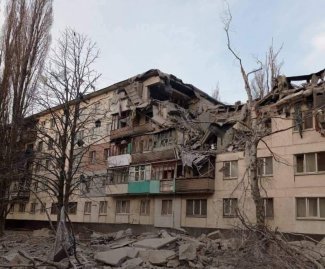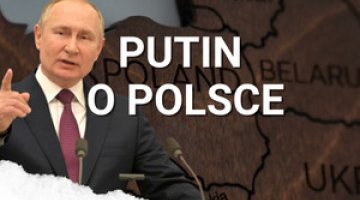Russia’s attack on Ukraine: day 35

Authorities in Ukraine and Western countries are signalling the withdrawal of some Russian forces from occupied areas in the Kyiv, Chernihiv and Sumy oblasts. The aggressor’s troops are said to be moving away to the north of Kyiv, as well as moving into Belarus. According to the Pentagon, around 20% of the units so far engaged in the north of Ukraine are to be redeployed to the east. According to the Ukrainian General Staff, due to the hindered formation of additional sub-units, the invader is expected to direct soldiers from security units and students of military colleges to fight. The military situation has not changed significantly for another 24 hours. The defenders report an increase in the frequency of bombing and shelling, especially of the villages they have recaptured in recent days. They also report that the retreating occupiers have mined them, with particular emphasis on buildings and public areas.
In the north-east, Russian troops have intensified shelling and bombardment of Ukrainian positions around Kyiv, including in Irpin (the return of residents will be impossible without the recapture of neighbouring Bucha, Vorzel and Hostomel, and subsequent reconstruction of these villages from damage), in Makariv and along the M06 highway west of the capital. Due to problems with ensuring the safety of railway traffic from Kyiv, trains from the east of the country (mainly from Kharkiv) are no longer diverted to the capital, but directly to the west. After several days of relative calm, the situation to the east was to be followed by fighting for Brovary on the evening of 30 March (in the Brovary area the invader still controls three municipalities). Chernihiv continues to be blockaded and bombed, and humanitarian columns with support for the city are also being shelled.
In the eastern direction, the Russians continued to shell and bomb Ukrainian positions in the Kharkiv, Luhansk and Donetsk oblasts. The defenders were to repel three attacks near Izium (street fighting is still going on in the southern part of the city, with the defenders encircled) and in the direction of Slavyansk. The aggressor troops eventually crossed over and fortified themselves on the south bank of the Donets River. Kharkiv and its outskirts remaining under Ukrainian control are being shelled and bombed. An invader was said to have destroyed an evacuation column to Kyiv in the village of Mala Rohan, which had been recaptured by the Ukrainians in previous days. In Donbas, Ukrainian forces were to repel a total of five hostile attacks. Popasna and Rubizhne in the Luhansk Oblast have been blockaded, but clashes continue there. Kreminna, Lysychansk and Sievierodonetsk are under shelling and bombardment for another 24 hours. In Donetsk Oblast, fighting is taking place over the villages of Novobakhmutivka, Mariyinka and Zolota Nyva. The defenders are expecting further attacks by the aggressor forces north of Gorlovka (towards Kramatorsk and Svitlodarsk) and north-east of Donetsk (towards Pokrovsk). The principal points of resistance in besieged Mariupol are expected to be the three main industrial sites.
In the south-eastern direction the defenders of the Kryvyi Rih were to regain control of the towns of Kochubeyivka, Orlove and Zahradivka on the border of the Kherson and Dnipropetrovsk oblasts. The aggressor, on the other hand, attempted to bypass the enemy’s positions from the west, advancing on Oleksandrivka on the border of the Mykolaiv and Dnipropetrovsk oblasts. There is no information on the situation south of Zaporizhzhia, where the previous day’s fighting continued on the Ukrainian defence perimeter. A Russian landing group is still being observed in the vicinity of Odesa, hostile reconnaissance is also ongoing and there are air attacks on targets in the Odesa Oblast. In a rocket attack, fuel storage facilities in the city of Dnipro, a plant in Novomoskovsk on its outskirts and a military unit in the Dnipropetrovsk Oblast were destroyed.
According to the information of the Ukrainian defence ministry, the aggressor forces replenished fire units in the port of Sevastopol on ships equipped with Kalibr cruise missiles (three frigates, six corvettes and six submarines). Ammunition replenishment was also reported on the frigate Admiral Makarov, among others. The Odesa authorities considered that this most likely meant that the Russians were preparing for further missile strikes on the Odesa Oblast and other oblasts of the country. On 30 March, President Volodymyr Zelensky established military administrations in eight towns in the Donetsk Oblast to replace the existing military-civil authorities.
A bill has been referred to the Verkhovna Rada of Ukraine that provides for financial gratification to enemy soldiers for surrendering themselves along with military equipment. Voluntarily handed over weapons will be covered by the following tariff in dollars: combat aircraft – 1 million, combat helicopter – 0.5 million, multiple launch rocket system – 25–30 thousand, tank – 100 thousand, infantry fighting vehicle or armoured personnel carrier – 50 thousand, wheeled vehicle – 10 thousand. Soldiers of the Russian army or other force structures who hand them over will be under the protection of the Ukrainian state, guaranteeing them, among other things, a change of identity.
According to information coming from Belarus, Russian soldiers are regularly brought to the Research Centre for Radiation Medicine in Gomel. They are suspected of having been contaminated by radioactive materials during their prolonged stay in Chernobyl area that still shows high levels of radiation, which have been further increased by forest fires.
On 30 March, 1,530 people reached Zaporizhzhia through three green corridors, 812 of them from Mariupol and the rest from occupied towns in the Zaporizhzhia Oblast. Contrary to earlier agreements, the Russians did not allow the refugees to leave Vasylivka, nor did they allow humanitarian aid to that town. Three green corridors are scheduled for March 31: from Mariupol via Berdiansk, from Melitopol and from Enerhodar. Ukrainian Railways has published another schedule of evacuation trains, which will include routes from Kramatorsk to Lviv, from Pokrovsk to Dnipro, from Lviv to Przemyśl, from Kyiv via Vinnitsa to Przemyśl, from Odesa to Przemyśl, from Kyiv to Warsaw, as well as to Košice, Vienna, Budapest and the city of Isaccea in Romania. The Russian side has reported that more than 3,000 people have left Mariupol and have been directed to Russia. The occupier’s tactics include placing the evacuees in filtration camps, where they will be subjected to psychological pressure to force the acceptance of the “new order”.
In the Kherson Oblast, the aggressor forces are continuing their actions to break the popular resistance. FSB and military officers from the 652nd Information and Psychological Operations Group are trying to implement a plan to establish a so-called people’s republic. To this end, “explanatory talks” are being held with local authorities and the population.
Presidents Volodymyr Zelensky held a telephone conversation with Joe Biden on 30 March. The US announced the transfer of $500 million to Ukraine for budget support. Zelensky also delivered an address in the parliament of Norway, in which he called for the delivery of air defence systems, anti-ship and anti-tank weapons. The president dismissed Ukraine’s ambassadors to Georgia and Morocco over allegations of ineffectiveness of their efforts aimed at persuading these countries to join the anti-Russian sanctions and arms supplies.
Online negotiations between Ukraine and Russia will resume on Friday 1 April along the same lines. The head of the Ukrainian delegation, Davyd Arakhamia, stressed that he hoped for a truce document to be drafted to enable an imminent meeting between the presidents of the two countries, and suggested that the best place for it would be Turkey. He added that one of the Ukrainian proposals related to security guarantees includes the concept of “enhanced resilience”, providing for the rapid mobilisation of up to one million reservists in the event of a military threat.
According to Finance Minister Sergii Marchenko, Ukraine has received more than $3 billion in direct budget support from the West since the beginning of the war. Further negotiations on a similar amount are underway. These funds have come in the form of various low-interest long-term loans, while Kyiv would prefer aid in the form of grants (so far only Italy has provided 110 million euros; talks with other countries are ongoing). In addition, the budget received early dividend payments from the state-owned Privatbank ($960m), the National Bank of Ukraine ($616m) and Naftohaz ($79m). Customs revenues fell by 80% compared to the pre-invasion period due to the blockade of ports and a significant reduction in trade.
The Polish Border Guard reports that since 24 February, 2.39 million people have entered Poland from Ukraine and 391,000 have crossed the border in the opposite direction. On 30 March, 25.5 thousand people were checked in (a 14% increase on the previous day).
Commentary
- The localities recaptured in recent days by Ukrainian forces increasingly resemble booby-traps, in which the defenders (as well as the population which is trying to evacuate) are tied down by the aggressor’s fire and exposed to losses due to their previous mining. Especially the latter circumstance proves that some of the localities were seized after the Russians had already retreated – for if the invaders had succumbed to the enemy’s pressure, they would not have been able to carry out the planned mining, especially in areas that were potential battlefields. Confirmed cases of armed recapture of control by the Ukrainian side involved mainly the liquidation of posts in smaller towns (Malynivka and Poltavka in the Zaporizhzhia Oblast) or the elimination of a security subunits in the enemy’s rear (Lukyanivka and Rudnytske on the border between the Kyiv and Chernihiv Oblasts). The Ukrainian army also seized the towns remaining so far in the strip of the so-called no-man’s land, outside the main positions of the fighting sides (such as taking of control over the towns south of the hitherto Ukrainian defence line of Kryvyi Rih). The defenders’ greatest military success so far was the displacement of the aggressor’s forces from Makariv, west of Kyiv, in early March.
- The occupiers are not abandoning their plans to detach Kherson Oblast and create a so-called people’s republic there. Their actions indicate that they do not intend to withdraw their troops from the area and most likely want to legalize its separation from Ukraine in order to create a strategically important land link with Crimea. Should this plan succeed, it will bring another violation of the territorial integrity of the Ukrainian state, and will thus be another factor preventing the conclusion of a peace agreement.
- The decision to create eight military administrations in the Donetsk Oblast means that defence in areas controlled by the Ukrainian army has been decentralised, and localities will defend themselves independently without coordination with the headquarters in Sloviansk. It also testifies to the ongoing fierce fighting in the oblast and the fact that the enemy still cannot occupy the entire area.





